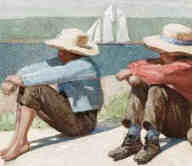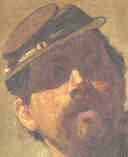Monet’s renowned series of the cathedral at Rouen seen under different
light effects was painted from a second-floor window above a shop opposite
the façade. He made eighteen frontal views. Changing canvases
with the light, Monet had followed the hours of the day from early morning
with the façade in misty blue shadow, to the afternoon, when the
sunset, disappearing behind the buildings of the city, weaves the weathered
stone work into a strange fabric of burnt orange and blue: The
Rouen Cathedral. Portail. The Albaine Tower. 1893-1894, The
Rouen Cathedral at Noon (1894), The
Rouen Cathedral (1893-1894), The
Rouen Cathedral at Twilight (1894), The
Rouen Cathedral in the Evening (1894).
In 1899, Monet first turned to the subject
of water lilies: The
White Water Lilies (1899), The
Japanese Bridge (1899), Water-Lilies
(1914), Water-Lilies
(c.1917), Water-Lilies
(1917), the main theme of his later work. Fourteen large canvases of
his Water lilies series, started in 1916, were bequeathed by him to the
State. In 1927, shortly after the artist’s death, these canvases were
placed in two oval rooms of the Musée de l’Orangerie in the Tuileries
Gardens.
— Claude Oscar Monet was a French impressionist painter who brought
the study of the transient effects of natural light to its most refined
expression.
Monet was born in Paris, but he spent
most of his childhood in Le Havre. There, in his teens, he studied drawing;
he also painted seascapes outside with the French painter Eugène
Louis Boudin. By 1859 Monet had committed himself to a career as an artist
and began to spend as much time in Paris as possible. During the 1860s
he was associated with the preimpressionist painter Édouard Manet,
and with other aspiring French painters destined to form the impressionist
school — Camille Pissarro, Pierre Auguste Renoir, and Alfred Sisley.
Working outside, Monet painted simple
landscapes and scenes of contemporary middle-class society, and he began
to have some success at official exhibitions. As his style developed,
however, Monet violated one traditional artistic convention after another
in the interest of direct artistic expression. His experiments in rendering
outdoor sunlight with a direct, sketchlike application of bright color
became more and more daring, and he seemed to cut himself off from the
possibility of a successful career as a conventional painter supported
by the art establishment.
In 1874 Monet and his colleagues decided
to appeal directly to the public by organizing their own exhibition.
They called themselves independents, but the press soon derisively labeled
them impressionists because their work seemed sketchy and unfinished
(like a first impression) and because one of Monet's paintings had borne
the title Impression:
Sunrise (1872). Monet's compositions from this time are extremely
loosely structured, and the color was applied in strong, distinct strokes
as if no reworking of the pigment had been attempted. This technique
was calculated to suggest that the artist had indeed captured a spontaneous
impression of nature. During the 1870s and 1880s Monet gradually refined
this technique, and he made many trips to scenic areas of France, especially
the Mediterranean and Atlantic coasts, to study the most brilliant effects
of light and color possible.
By the mid-1880s Monet, generally regarded
as the leader of the impressionist school, had achieved significant recognition
and financial security. Despite the boldness of his color and the extreme
simplicity of his compositions, he was recognized as a master of meticulous
observation, an artist who sacrificed neither the true complexities of
nature nor the intensity of his own feelings. In 1890 he was able to
purchase some property in the village of Giverny, not far from Paris,
and there he began to construct a water garden (now open to the public)—a
lily pond arched with a Japanese bridge and overhung with willows and
clumps of bamboo.
Beginning in 1906, paintings of the pond
and the water lilies occupied him for the remainder of his life; they
hang in the Orangerie, Paris; the Art Institute of Chicago; and the Museum
of Modern Art in New York City. Throughout these years he also worked
on his other celebrated “series” paintings, groups of works representing
the same subject—haystacks, poplars, Rouen Cathedral, the river Seine—seen
in varying light, at different times of the day or seasons of the year.
Despite failing eyesight, Monet continued to paint almost up to the time
of his death, on 05 December 1926, at Giverny.
— Painter, artist. Initiator, leader, and unswerving advocate of
the Impressionist style. In mature works, developed method of producing
several studies of the same subject in series, changing canvases with
the light or as his interest shifted. These "series" were generally dated
and were often exhibited in groups. Moved with his family to Le Havre
in 1845. He attended public school in Le Havre and learned to draw from
François-Charles Ochard, although the early instruction he received
from Eugène Boudin was more critical. In 1859 Monet traveled to
Paris where he attended the Académie Suisse and began a friendship
with the older Camille Pissarro. He received formal art training in 1863
in the studio of Charles Gleyre, where he met Bazille, Renoir, and Sisley.
Despite the acceptance of paintings at the Salons of 1865 and 1866, he
suffered severe financial problems.
In 1873 Monet and other artists in his
circle formed the Société Anonyme Coopérative d'Artistes-Peintres-Sculpteurs-Graveurs,
which in 1874 held its first group show, later known as the first impressionist
exhibition. Monet exhibited Impression:
Sunrise, the painting from which the impressionists derived their
name. Monet also participated in the second (1876), third (1877), fourth
(1879), and seventh (1882) impressionist exhibitions. During his career,
Monet painted in a number of locations throughout France as well as in
London, Venice, the Low Countries, and Scandinavia. He established studios
at Argenteuil (1871), then Vetheuil (1878), and finally Giverny (1883),
where he bought a house and property in 1890 and began to concentrate
on the famous paintings of his gardens. As Monet grew older, his eyesight
deteriorated, but despite his failing vision, he continued to paint until
his death. His last years were preoccupied by his grand cycles of water
lily paintings.
— LINKS
— Direct
links to reproductions of 189 paintings — Water
Lilies (1916) — Waves
Breaking (1881) — Sailboats
on the Seine (1874) — The
Grand Canal, Venice (1908) — Garden
in Bordighera, Impression of Morning — Impression:
Sunset, Pourville (1882) — Impression:
Sunrise (1872) |

 ^
05 December 2002: Major auction
of US art at Christie's
in New York.
^
05 December 2002: Major auction
of US art at Christie's
in New York. —Study
for ‘The Wounded Drummer Boy’ [< thumbnail]
by Eastman
Johnson [1824-1906] —
—Study
for ‘The Wounded Drummer Boy’ [< thumbnail]
by Eastman
Johnson [1824-1906] —  —
Girl
in the Hammock by Winslow
Homer [1836-1910] — A
Shady Spot, Houghton Farm by Homer
—
Girl
in the Hammock by Winslow
Homer [1836-1910] — A
Shady Spot, Houghton Farm by Homer